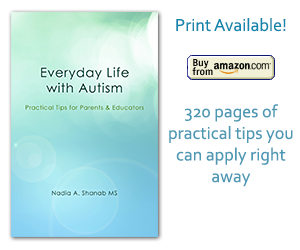How Is The Brain Wiring Created?
By Nadia Shanab | UncategorizedIn a child development class I learned that a newborn’s brain has a huge number of connections between the cells (neurons). Imagine these connections forming a network. If some connections are more used than others (due to a heavy traffic on these communication lines), these pathways become well-established. The connections that are less used, get
Why Is Autism on The Rise?
By Nadia Shanab | UncategorizedIt is a worldwide phenomena that the diagnosis with autism is on the rise, even in underdeveloped countries. What might the reason be? Diagnostic criteria are changing Screening tools have developed Increasing research on the topic Increased health services New environmental factors (pollution of air, oceans,…) Increased awareness of the condition Social factors I believe
My Article in The “San José Mercury News”
By Nadia Shanab | UncategorizedYou can read my new article about meanstreaming in the online edition of the San José Mercury News or in the Cupertino Courier local news edition. Click here. nadia
What Is Autism? Watch The Video
By Nadia Shanab | UncategorizedYou have probably been reading in books, magazines and the Internet to learn about autism. Here is shortcut for you. I chose this video from the CDC for you. Watch the video. You need more details? Watch this video about Autism Spectrum Disorders. nadia shanab
The Importance of Art for Autistic Kids
By Nadia Shanab | UncategorizedQ: What does practicing art do to anybody? A: It expresses a person’s feelings, thinking, talents and wants. Children with autism are most of the time stuck inside their own mind. They have poor communication abilities, it is hard for them to initiate any conversation, therefore, they avoid talking to others. Their social skills are
Build on Strengths Not on Deficits
By Nadia Shanab | UncategorizedEvery person, whether on the autism spectrum or not, has got a set of deficits or weaknesses: mental capacities, physical capabilities or social skills, among many more. On the other hand, the set of strengths and talents a human being has been endowed with are endless. Why do most people focus on what’s not working so
TOBY Playpad: A Unique iPad App for Parents, Educators and Therapists
By Nadia Shanab | UncategorizedTOBY playpad: TOBY Playpad is a unique, therapist-and-parent designed Early Intervention application for children with Autism. TOBY’s iPad tasks co-ordinate with off-iPad tasks to help your child learn skills in the real world. TOBY stands for Therapy Outcomes By You, because it aims to empower parents to commence early intervention to maximize your child’s development.
Favorite Play for Kids with Autism
By Nadia Shanab | Uncategorized“Children with ASD (Autism Spectrum Disorders) choose to engage in play that provided strong sensory feedback, cause-and-effect results, and repetitive motions,” said Doody the assistant professor of exceptional education at SUNY Buffalo State. In a research conducted by Doody and Mertz, the most popular activity was “climbing stairs”. Children would through the ball and observe the
Autism Linked to Fine Motor Skills Deficits
By Nadia Shanab | UncategorizedA recent research at Oregon State University showed a link between poor fine motor skills and autism. Autistic children with better motor skills also perform better at social skills and vice versa. Nobody really knows why. Studies and researches used to focus on social skills and communication, and giving little attention to motor skills deficiency. However,


